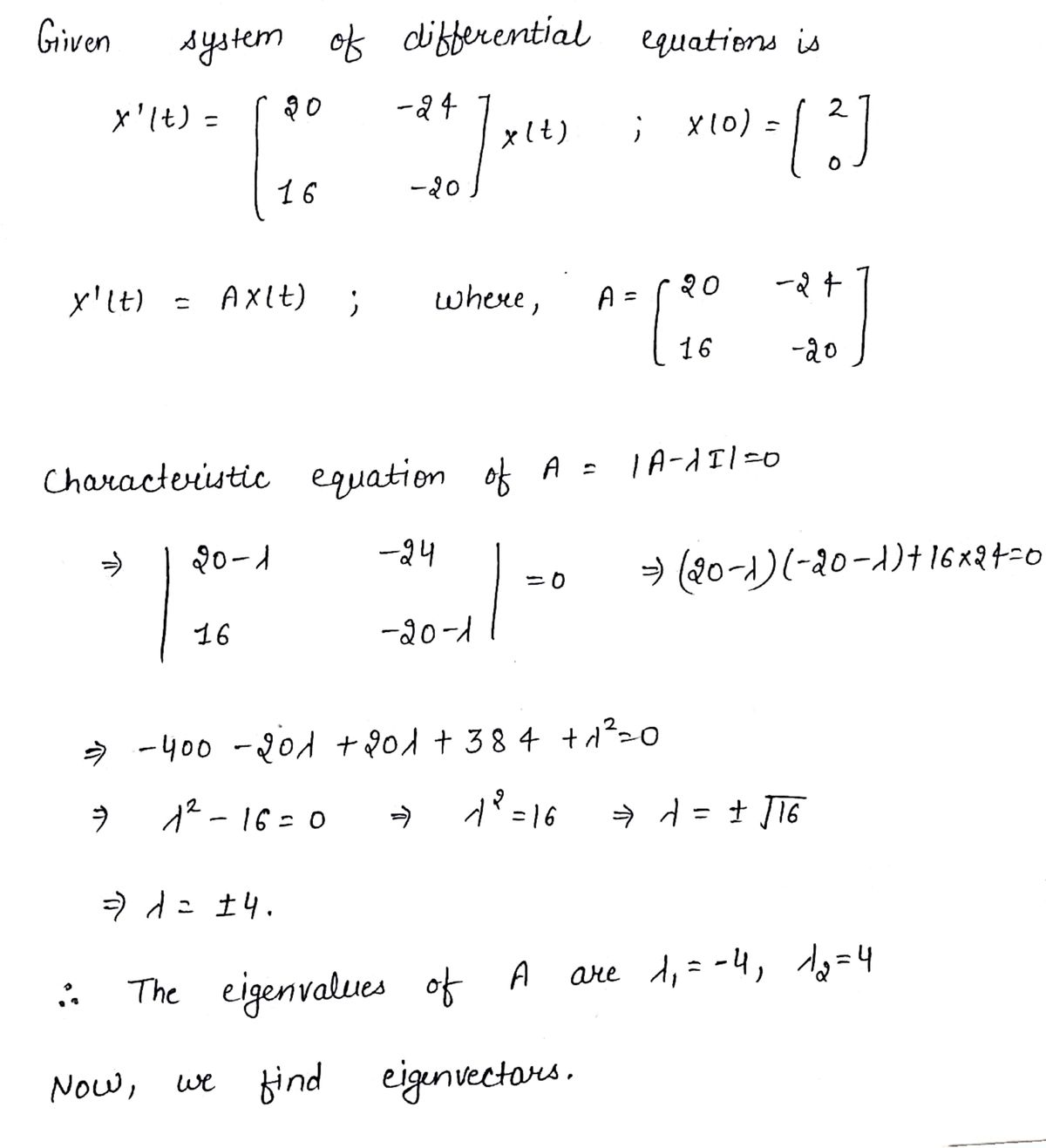xcese X²(t)= [20 24 ] x -20 = [3] x(0) =
Advanced Engineering Mathematics
10th Edition
ISBN:9780470458365
Author:Erwin Kreyszig
Publisher:Erwin Kreyszig
Chapter2: Second-order Linear Odes
Section: Chapter Questions
Problem 1RQ
Related questions
Question
Solve for the solution x(t) to the system of differential equations
![The image contains a system of differential equations represented in matrix form. The system is as follows:
1. The derivative of the vector \( x(t) \), denoted \( x'(t) \), is given by the matrix multiplication:
\[
x'(t) = \begin{bmatrix} 20 & -24 \\ 16 & -20 \end{bmatrix} x
\]
Here, the matrix:
\[
\begin{bmatrix} 20 & -24 \\ 16 & -20 \end{bmatrix}
\]
is the coefficient matrix, and \( x \) is the vector of variables, typically denoted as \( x = \begin{bmatrix} x_1 \\ x_2 \end{bmatrix} \).
2. The initial condition for the system is given by:
\[
x(0) = \begin{bmatrix} 2 \\ 0 \end{bmatrix}
\]
This means that at time \( t = 0 \), the vector \( x \) starts with the values \( x_1 = 2 \) and \( x_2 = 0 \).
These equations form a linear homogeneous system, which can be analyzed to study the dynamics of the solution over time.](/v2/_next/image?url=https%3A%2F%2Fcontent.bartleby.com%2Fqna-images%2Fquestion%2F6d0ee2cb-cfe2-4eb9-a097-d38324436758%2F885449d4-3b16-4c6b-b6ba-ed0799594f9e%2Fy7cs2od_processed.jpeg&w=3840&q=75)
Transcribed Image Text:The image contains a system of differential equations represented in matrix form. The system is as follows:
1. The derivative of the vector \( x(t) \), denoted \( x'(t) \), is given by the matrix multiplication:
\[
x'(t) = \begin{bmatrix} 20 & -24 \\ 16 & -20 \end{bmatrix} x
\]
Here, the matrix:
\[
\begin{bmatrix} 20 & -24 \\ 16 & -20 \end{bmatrix}
\]
is the coefficient matrix, and \( x \) is the vector of variables, typically denoted as \( x = \begin{bmatrix} x_1 \\ x_2 \end{bmatrix} \).
2. The initial condition for the system is given by:
\[
x(0) = \begin{bmatrix} 2 \\ 0 \end{bmatrix}
\]
This means that at time \( t = 0 \), the vector \( x \) starts with the values \( x_1 = 2 \) and \( x_2 = 0 \).
These equations form a linear homogeneous system, which can be analyzed to study the dynamics of the solution over time.
Expert Solution
Step 1: Finding eigenvalues

Step by step
Solved in 4 steps with 4 images

Recommended textbooks for you

Advanced Engineering Mathematics
Advanced Math
ISBN:
9780470458365
Author:
Erwin Kreyszig
Publisher:
Wiley, John & Sons, Incorporated

Numerical Methods for Engineers
Advanced Math
ISBN:
9780073397924
Author:
Steven C. Chapra Dr., Raymond P. Canale
Publisher:
McGraw-Hill Education

Introductory Mathematics for Engineering Applicat…
Advanced Math
ISBN:
9781118141809
Author:
Nathan Klingbeil
Publisher:
WILEY

Advanced Engineering Mathematics
Advanced Math
ISBN:
9780470458365
Author:
Erwin Kreyszig
Publisher:
Wiley, John & Sons, Incorporated

Numerical Methods for Engineers
Advanced Math
ISBN:
9780073397924
Author:
Steven C. Chapra Dr., Raymond P. Canale
Publisher:
McGraw-Hill Education

Introductory Mathematics for Engineering Applicat…
Advanced Math
ISBN:
9781118141809
Author:
Nathan Klingbeil
Publisher:
WILEY

Mathematics For Machine Technology
Advanced Math
ISBN:
9781337798310
Author:
Peterson, John.
Publisher:
Cengage Learning,

